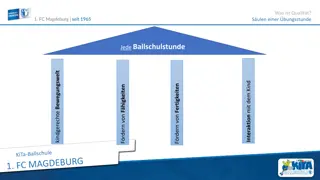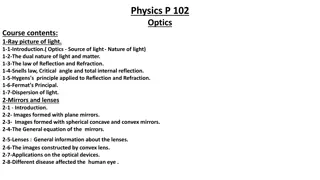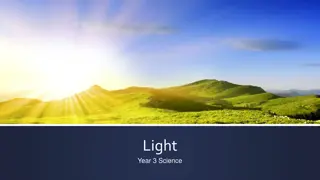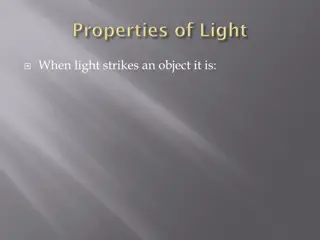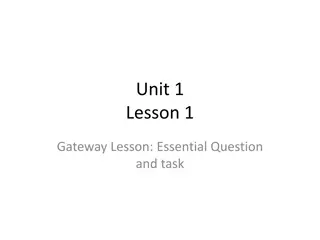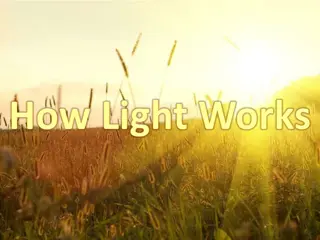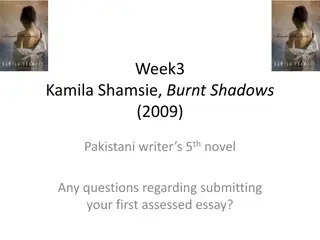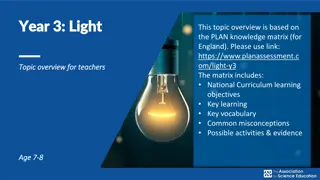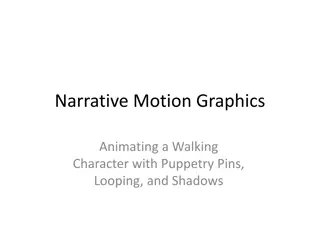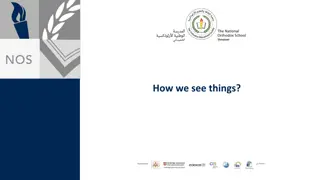Understanding Shadows and Light Interaction for Kids
Explore the formation of shadows and how different materials block light to create shadows in this engaging educational activity for kids. Discover how light travels, the properties of transparent, translucent, and opaque objects, and embark on a shadow walk to observe shadows in various settings. Engage in practical experiments and a fun object treasure hunt to deepen understanding of light interactions with materials.
Download Presentation

Please find below an Image/Link to download the presentation.
The content on the website is provided AS IS for your information and personal use only. It may not be sold, licensed, or shared on other websites without obtaining consent from the author. Download presentation by click this link. If you encounter any issues during the download, it is possible that the publisher has removed the file from their server.
E N D
Presentation Transcript
WALT: - recognise how shadows are formed - materials block light to form shadows. investigate which
Starter Task Quick recap! Think back to what you have learned so far about light and answer the following questions as quickly as you can on a piece of paper! Describe how mirrors help us see things Name at least 3 sources of light Write down three good things that the sun does Write down three dangers of the sun
Today, we are going to focus on how shadows are formed and then you are going to use this knowledge to help you work out which materials block light to form shadows.
Introduction Shadow walk! Go into your garden or on a walk with an adult when it is sunny. Make sure you are wearing sun cream and protecting yourself from the sun with sunglasses and a hat. How many shadows can you spot? How do you think the shadows are made? What is needed to make a shadow?
Activity 1- How does light travel? Light is a beam of energy that travels in a wave from a source. A wave of light can only travel in a straight line. Waves of light are called light rays. Try this activity to demonstrate how light travels: 1. With help from an adult, carefully punch holes in the centre of three equal-sized pieces of card. 2. Hold the pieces of card so that the holes line up. 3. Shine a torch so that the beam of light can travel straight through the holes. What happens if you move one of the pieces of card so the holes don't line up? When you moved one of your pieces of card so the holes did not line up, the card blocked the ray of light. This is because light can only travel in a straight line, so it can not travel around the card.
Light and different types of materials Click on the link below to find out how light behaves with different materials : https://www.bbc.co.uk/bitesize/clips/zg6r82p Transparent objects let light travel through them easily. Translucent objects let through, but scatter the light so we can't see through them properly. some light Opaque objects like the card, block light well and don't let any get through.
Activity 2- Object Treasure Hunt Can you find examples of transparent, translucent and opaque objects in your house?
Transparent, translucent and opaque objects What examples did you find for each column?
Activity 3- Whats the Use? Opaque, translucent and transparent materials are all useful for different things. Look at the items below and decide which type of material would be best for each one: living room curtains bathroom window car windscreen window with a lovely view shower curtain sun hat Remember to explain your reasons why!
Making Shadows Opaque objects do not let any light through. They completely block the light and stop it travelling any further. These objects create shadows. Shadows are areas of darkness where light has been blocked.
Main Activity- Choosing Materials This is Isaac. He has a new baby sister. She is a very good baby, but she keeps crying early in the morning because too much light is getting into her bedroom and waking her up. Isaac wants to choose the best material to make some new curtains for her bedroom. He wants to make sure that her new curtains block as much light as possible. Can you help him?
Plenary Which materials did not let light through? Which would be best for the curtains? Explain your reasons to somebody at home!


